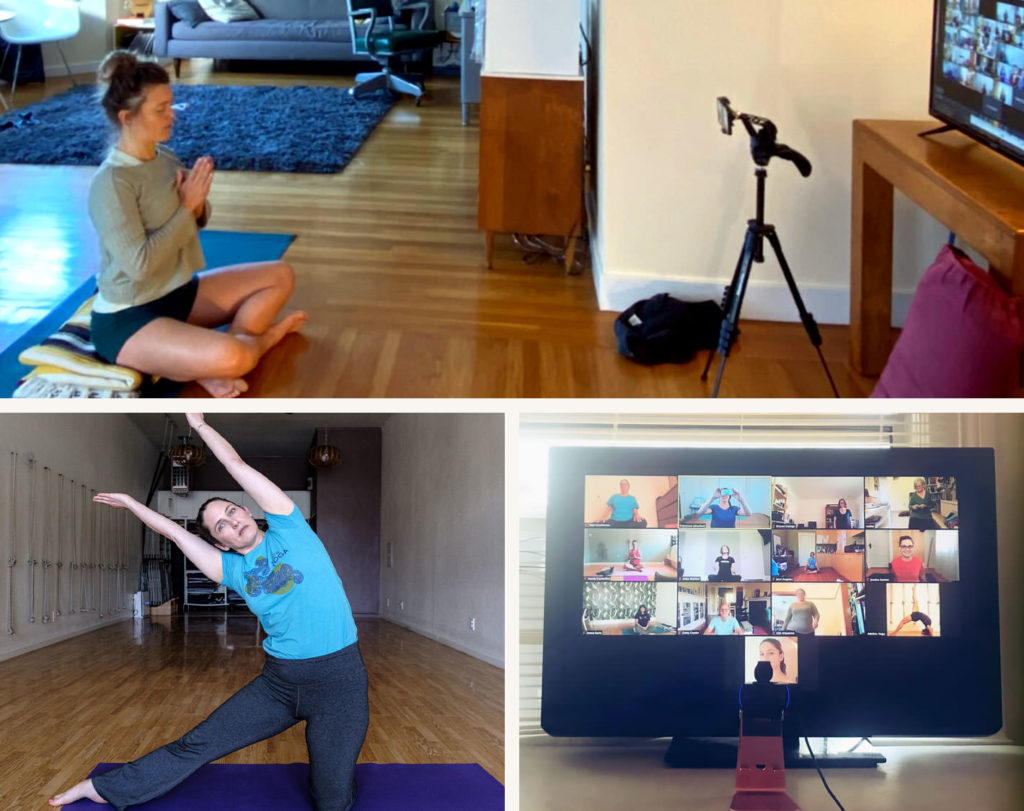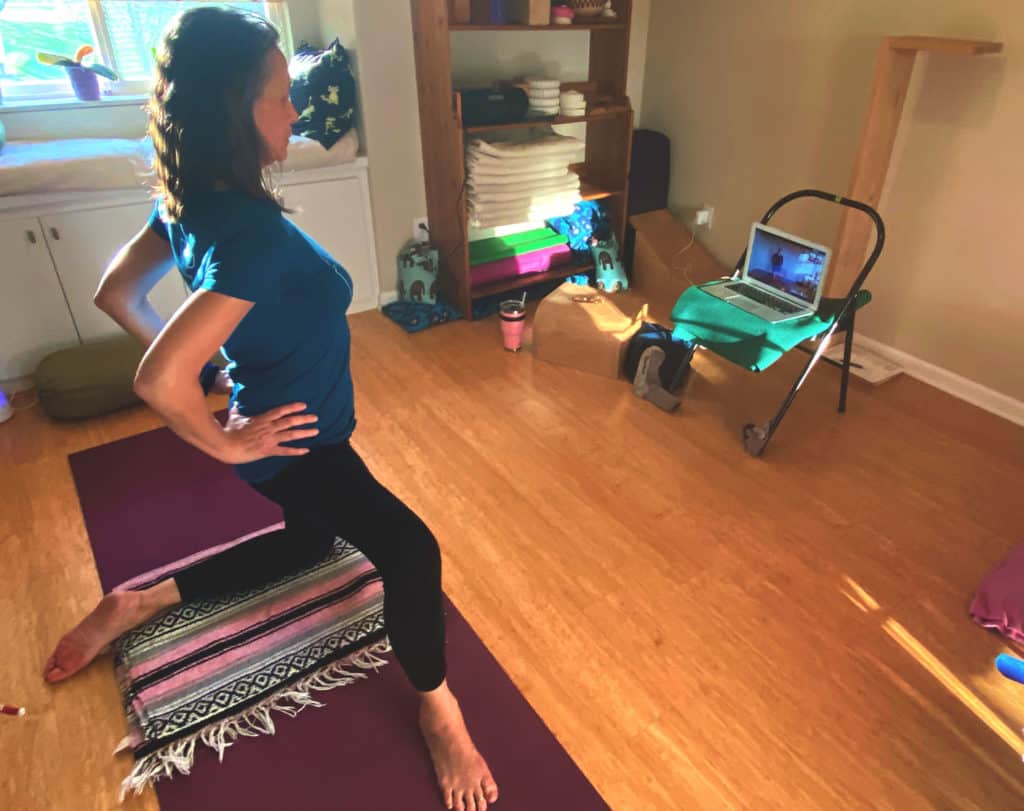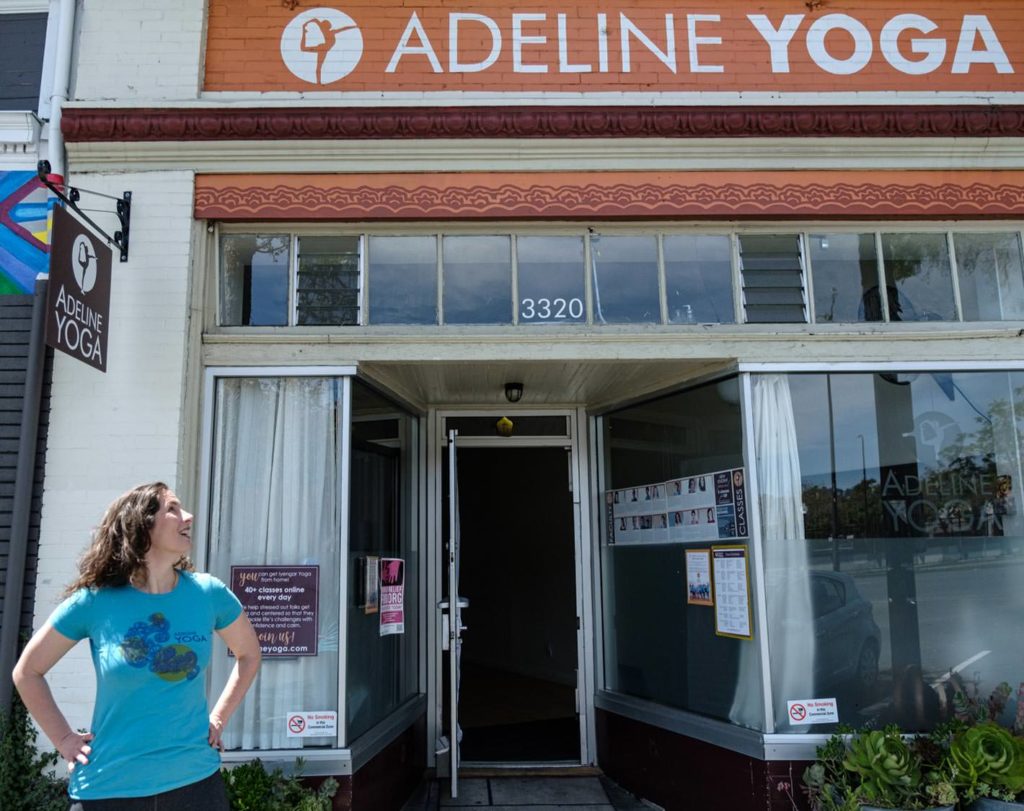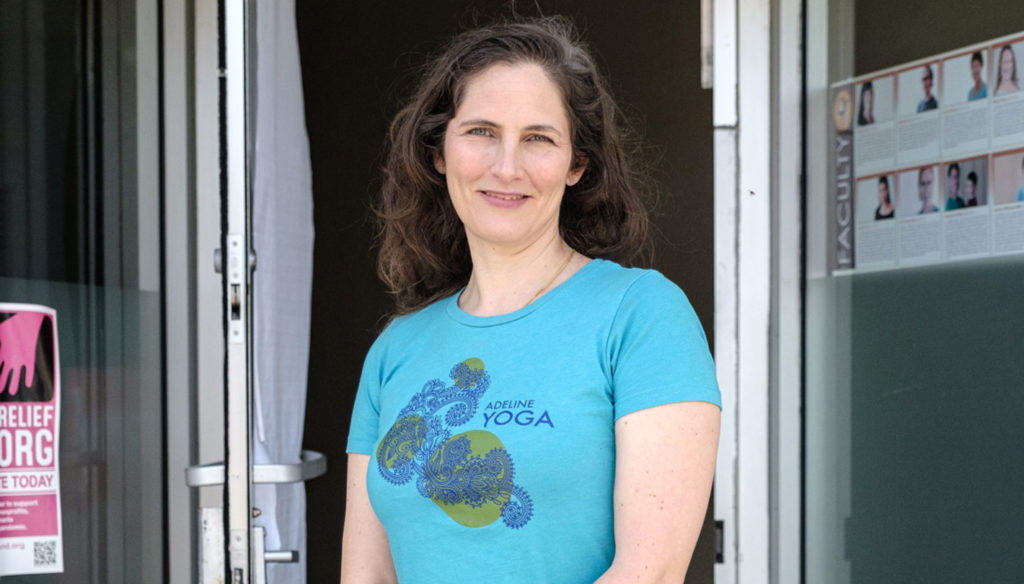Heather Haxo Phillips, of Adeline Yoga, is proof of the power of value-centered thinking in times of trouble.
On a Thursday in March, facing a weekend teaching schedule packed full of yoga classes, COVID-19 was nowhere near Haxo Phillips’ radar. But that night, she learned that several studio owners she knows and respects were closing down. Realizing she could become a vector for the fast-spreading COVID-19 as a teacher in group settings, she made the decision to close. “The writing was on the wall,” she says, “and I needed to get with the program fast.”
On Friday morning, she announced the entire class schedule would move online. Starting that weekend.
First step? Asking a teacher heading into a vacation to pull out her iPhone and Zoom her class. “So on Saturday morning, she got online with her first online class ever,” says Haxo Phillips. Once that proved successful, she knew the studio could survive. But, she says, “That was when all the hard work had to begin.”
By Monday, the studio had already hosted a slew of online yoga classes, started work on a new pricing structure, and was in the early days of a new business model — with a revenue stream that could continue even after in-person classes resume.
In this process, Haxo Phillips did a whole bunch of things we consider central to Value-centered Innovation (VCI), part of our innovation methodology in which we define an objective, form a delivery team, and establish a practice of rapid experimentation to achieve big results with less effort.

VCI for the habit of rapid experimentation
Experimentation is why Heather Haxo Phillips is not only still in business, but also now serving yoga students all over the world using teachers all over the country. “Some things don’t work out, and we rebound quickly,” she says, “and the things that do work out, we just keep working with.”
This is why VCI, with rapid experimentation as a core practice, is the road to resilience in times of trouble.
A habit of rapid experimentation enables the ability to spot a need by seeking out and listening to evidence. It means being able to absorb information, assess its meaning, and act accordingly. It means being able to pivot away from bad ideas, lean into good ones, and use every tool in your garage to build value where before there was none.
For Haxo Phillips, one such experiment involved being willing to use many different platforms across the business. “By the end of the week, we were on like six different platforms.” Settling on one, and combining it with their online registration software, which they had to “trick out” so it would auto-send class links, the studio quickly found a rhythm and was able to make the move to the Internet.
The work wasn’t over; they then had to make the change sustainable. “I didn’t eat or sleep, really, for a week.” But it’s because the team was already in the habit of experimenting that it had the opportunity in the first place.
VCI for improvising
As much as VCI creates stability in team practices, it also depends on a willingness to improvise. Any number of product development activities can be pulled from the toolkit on a given day to decide what to do next and how to act on new information. This might include a Rapid Experiment Canvas, or a Minimum Viable Test Matrix for choosing the approach to a MVT, or a quick ideation studio in which the team brainstorms “alone together” to generate design ideas.

In Haxo Phillips’ case, improvising meant reaching out to a student of hers who was now stuck in Guatemala (and still is today). Though she couldn’t work, this student had a strong Internet connection and a willingness to dive in. So Haxo Phillips hired her to teach. Weeks later, she now teaches the earliest morning classes from the comfort of her later time zone when the other teachers are still waking up.
By improvising, Haxo Phillips was able to take all the supposed disadvantages of the situation and turn them into advantages.
VCI for enabling pivots
One of the benefits of rapid experimentation is that it teaches us how to pivot. Since one of the goals of a hypothesis test is to weed out bad ideas, experimentation teaches us to pivot. With our brains constantly primed to pivot on a small scale, it becomes much easier on a large scale.
“If you’re in the habit, it goes smoothly. If you’re not in the habit: what a freaking disaster.”
To this end, Haxo Phillips keeps a team around her that is always ready to try new things. In fact, she interviews for this trait, always looking for people who can roll with “unstable environments, which is all environments all the time.”
VCI for team health
Team health is among the most overlooked aspects of product development, but the willingness of a team to consciously work to improve itself is critical to its success.
Haxo Phillips knows this. “I interview really carefully and I train really carefully,” she says, “and I nip problems in the bud.”
First, she hires for people who are stable in their lives, have “a rhythm to their day,” and who are excited about things. She looks for enthusiasm, and she continually works to build relationships with her employees.
In VCI, a big part of how we achieve team health is through delivery team retrospectives. By holding periodic “start/stop/continue” sessions, team members are given equal opportunity to voice concerns about what’s not working well, and to promote what is. We like to run these more frequently at first — every two weeks — and perhaps less frequently (monthly) as things stabilize. We also like to appoint someone (usually a program manager or product owner) for governance between sessions, to ensure someone is minding the process and fielding comments that can be brought up at the next one.
(Pro tip: Running these sessions via silent brainstorming and voting exercises reduces the risk of stronger voices dominating the conversation.)
VCI for rapid discovery
One of the most fundamental aims of VCI is to determine early and often which ideas are strongest, and which assumptions carry the most truth. In doing this, we can quickly discover what to focus on and, conversely, what to stop focusing on.

Through her rapid work, Haxo Phillips determined in one weekend that her studio’s community would indeed be willing to move to online classes — that not only was the idea possible, it was viable as a business model. She tried multiple video platforms. She and her staff used multiple gear setups (varying phone models and audio inputs). She determined that her online registration software could automate class links, and was able to test whether this was effective for moving her classes online.
VCI for risk mitigation (in product dev)
And of course, the reason we want to determine which ideas are good early on is so we can minimize risk in the product development process.
Most product development methodologies are full of risk. Typically, they require that you do a hefty amount of prep work prior to launching some degree of the perfect thing, without ever being able to prove the value of the idea until after launch day. As such, most products are based on qualitative and even anecdotal input. They’re based on someone’s belief that the idea is good, that the solution will be beneficial. Most products are not based on evidence.
In trying multiple platforms and enlisting the help of students and colleagues alike, Haxo Phillips dramatically reduced the risks of such a big business model change. This is why she was able to execute on it so quickly.
The lesson to take away here? It’s something we talk about a lot in Value-centered Innovation:
Do the least to gain the most.
* * *
When you focus on value, on experimenting your way toward an objective, and on being ready and willing to respond to new information, every situation becomes one of potential growth.
Global pandemics, bad economies, and tightened budgets no longer have to signal the death of opportunity. It’s what turns constraints into opportunities. Just ask Heather:
“We expanded. We went from 30 classes a week to 40 classes a week. I hired six new staff people.”


